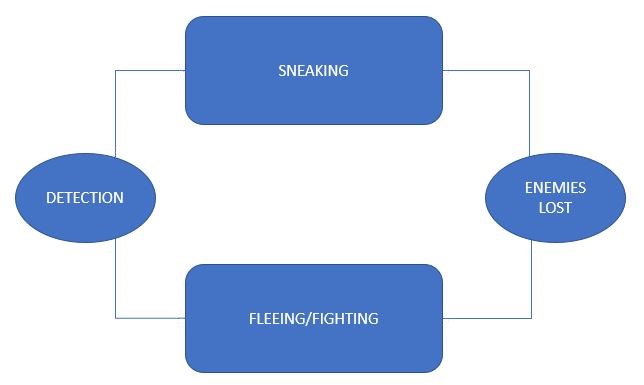How to design stealth games?
- April 22, 2022
- Karolina Cieślak
Stealth games are one of the industry’s most important genres. Games like the Dishonored series, Thief, early Assassin’s Creed, or Hitman took the world by storm. Stealth mechanics play an important role even outside of typical stealth games. This is the case, for example, in games from the Uncharted series, Tomb Raider, or Cyberpunk 2077.
What makes stealth games so popular? What is the appeal of sneaking, putting on disguises, and feeling the thrill of possibly getting spotted by the enemy? What are the pillars of a good stealth game? How to set the right pace?
In this text, I will try to answer these questions and offer some tips on designing a stealth game. You will learn how to create a stealth game that will offer players the desired experience and keep them engaged in the game quickly and for a long time.
What is a stealth game, and what kind of experience does it offer?
Stealth is a very specific genre. There are a plethora of stealth games on the market, and although each one is different, the core of each one is the same.
The psychology of sneaking
In a nutshell, a stealth game, or stealth sequence, is about balancing between two states. One is stealth, a state where the player hides from enemies and tries to complete the level while in hiding. The other state is detection, escape – it occurs when the player is noticed.
In stealth games, the player is motivated by uncertainty and fear. Once you get detected and attacked, the whole plan will fail.
It may seem paradoxical, but most gamers like to feel this anxiety. It would be an unpleasant emotion that they would try to avoid in real life. But, conversely, it can be experienced safely in games, allowing the player to experience the thrill without fear of real harm.
On the other hand, a player in a stealth game doesn’t have to be a victim at all – they can also be a hunter who uses their advantage to set traps for their enemies. In that case, the dominant emotion felt by the player is not anxiety but rather a desire for achievement, a sense of superiority over their enemies. To feel superior to their enemies, the player can use the skills and knowledge they gain during gameplay (e.g., about enemies’ movement patterns) and various items.
There is another phenomenon, described in 2013 by the American Psychological Association, that sheds additional light on why gamers like stealth games – it has been dubbed the ’cheater’s high’. The study involved 1,000 adults who took part in a series of competitions where word puzzles had to be solved. Participants were given the opportunity to cheat – and it turned out that those who chose to do so did not feel guilty at all – on the contrary, their mood improved significantly!
Why does this happen?
Finding a successful way to cheat, to ‘get around the system’, gives people a sense of accomplishment – it allows them to feel clever and intelligent – which is what triggers the cheater’s high.
Dr. Lennart Nacke, human-computer interaction specialist, says that cheater’s high is a phenomenon that is very often experienced in stealth games
The basic stealth loop
Let’s discuss the basic stealth loop in more detail, namely the two previously mentioned pillars of the genre – stealth and escape.
As mentioned earlier,
in stealth games, the player can generally be in two states – sneaking and fleeing/fighting.
The first, which is usually where the gameplay starts, is where the player is in stealth – the enemies are unaware of his presence, and the player’s task is to complete the level by sneaking past them unnoticed. Once detected, the player enters the second state, escape, and/or combat. When the guards notice him, they become aware of his presence and try to catch or defeat him. Then the player’s task is usually to escape or defeat the enemies aware of his presence so that the enemies are again unable to locate him and return to the state of sneaking.
The model shown above is very simplified and shows only the basis of stealth. There can be different sub-states between the stealth and escape states, depending on the exact experience the game is intended to offer. Below we discuss the two pillars of stealth in detail.
The first pillar – sneaking
In the stealth state, the player is invisible to enemies – and that’s how they are supposed to stay. You can say that the environment is then divided into safe and dangerous zones. The player is unconditionally hidden in safe zones, and no one can see him – this could be high grass in Horizon Zero Dawn, a haystack in Assassin’s Creed, or a crate in Hitman. Other areas are zones where the player can potentially be spotted, e.g., when they enter a guard’s field of vision. There are usually many more danger zones, which gives the game a balanced difficulty level.
How do the guards work?
Guards, understood as enemies who can detect the player, usually use two senses – sight and hearing.
Games usually implement the so-called vision cone to represent the guards’ field of sight visually. This area is “glued” to the guard’s face and expands forward to a certain point, as shown in the image below.
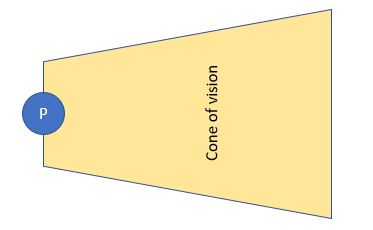
Although this is the basic cone, it is used less and less in practice, especially when developers strive for the highest possible realism. In many games, the guards’ field of vision is often extended to include “peripheral vision”. In some cases, it also includes a small area at the back of the head that simulates a sixth sense, through which they can sense that someone is behind. This type of guard’s viewing area is shown in the graphic below.

For realism, this is a much better approach than the previous one. It is also appropriate when you want the player to feel a stronger sense of unease (e.g., in stealth sequences in survival horror games).
In 3D games, the cone of vision works spreads in multiple directions, and an invisible line is often used, running from the guard’s eyes to one or more points on the protagonist’s body (usually the head).
If you want to add even more realism, there can be more lines running from the guard’s eyes to the player character’s body, like in Splinter Cell, where the lines go up to 8 bones in Sam Fisher’s body.
Then even if only his leg or arm is sticking out from behind the curtain, the guard will detect him. But suppose there is an obstacle between all the lines connecting the guard’s sight to the character. In that case, the character will not be detected.
The sense of hearing needs a different approach as “hearing” is not directional, and the area spreads out in all directions from the player or object that made the sound. If a guard is in this area, he will be alerted. Of course, obstacles such as walls can reduce sound propagation.

Second pillar – fight/flight
The stealth loop diagram above shows that, in case of detection, the player enters a state of escape or combat. Then the guards become aware of the player’s presence and start searching the area or open fire.
The matter is, of course, a little more complicated. First of all, when designing a stealth game, you need to decide when the complete detection should take place. The first option is to enter the fight/escape state as soon as the player is within sight or hearing range of a guard. However, this approach is not fair. As we wrote in our text, Feedback in games, the player should be able to avoid punishment, in this case, total detection, before taking the appropriate action.
From being spotted by the guard to the state of escape, the player must be given time to react, hide or escape.
In practice, this is often solved by the alerted guard entering a state of suspicion. The guard then slowly begins to approach the player, and a warning marker appears above his head – ideally yellow, as this is immediately associated with a warning. When the marker fills up and the player does not escape from the danger zone, the player enters the escape mode.
And what should happen once we are detected and enter the escape state? The easiest solution is to enter an open fire state, such as in Uncharted. When Drake is detected, he is immediately attacked by all enemies in the area. What’s more, everyone is well aware of his exact location, even those who wouldn’t physically be able to figure out where Drake is. It is, therefore, a solution that is better avoided.
If you want to alert all the enemies in the area when the player is detected, there’s a slightly different solution – more logical and fair from the player’s point of view.
In Middle-earth: Shadow of Mordor, before sounding the alarm, the first alerted enemy must walk a certain distance to alert the other guards. In this way, the player is given time to capture the alerted guard and prevent alerting other guards. This gives the player a greater sense of control and overall fairness to the game.
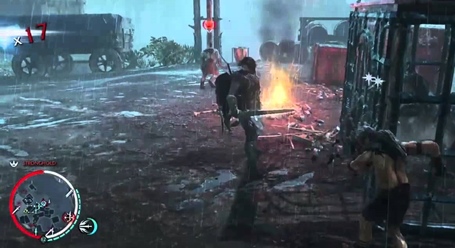
In stealth games, of course, there should be an option to alert several guards simultaneously. However, they should be near each other to make it physically possible to communicate (ideally, these verbal messages should be audible to the player). Alternatively, they could enter the alert state when they notice something weird. For example, it adds realism if the guards start searching for the player whenever they see a body or an incapacitated guard.
The player must have the ability to re-enter the stealth state, for example, using gadgets or skills, e.g. if they manage to hide for a long enough period.
The “nervous” state is another interesting way to add realism to a game. For example, if the player manages to escape and re-enters the stealth state, the guards may be in a state where they are suspicious.
Player advantage?
In stealth games, the player should have some advantage over the enemy to make the gameplay more interesting. This can be achieved, for example, with special abilities or gadgets or information that the player can get during the game. For example, Batman has a rope, which he uses to rappel up and hide on the gargoyles above. For example, by completing a task or finding a hidden room, the player can obtain a map of the rooms, which will give him the ability to better plan his actions.
Here is how the player can deal with stealth sequences:
- Distractors – the player has objects with which he can distract the enemy or lure him somewhere –stones or bottles, for example, as in The Last of Us.
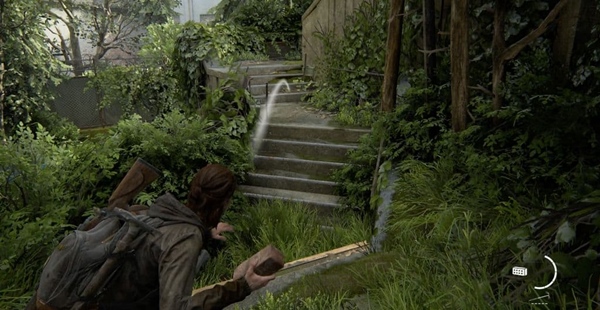
- Changing the behavior of guards – the player can influence guards’ behavior in a certain way. An example would be the arrows in Assassin’s Creed IV: Black Flag, which cause guards to hit with them to attack their own.
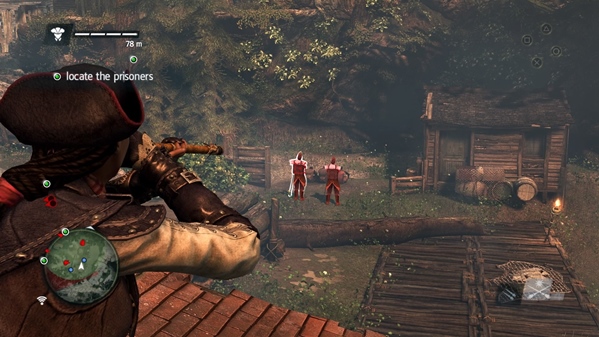
- Space manipulation – broadly speaking, this involves turning dangerous areas, where there is a high probability of detection, into safe areas. For example, if in a game we are only safe in the dark, the player can find a way to turn off the lights in the entire area. Disguises that make the player unrecognizable by guards (as in the Hitman series) can also fall into this category.
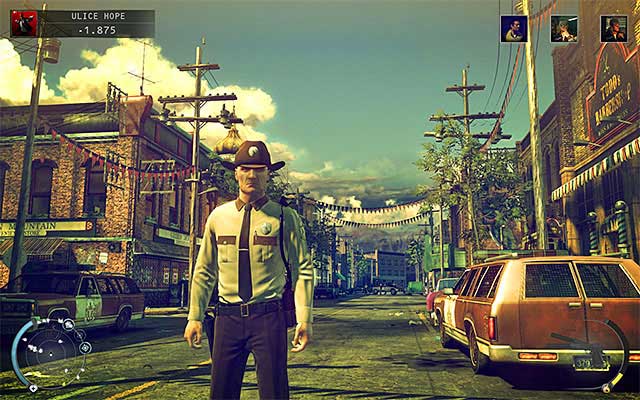
- Changing the way you move – the player moves from dangerous to safe areas. Examples include Batman using a rope to jump onto gargoyles or Sam Fisher performing split on walls.
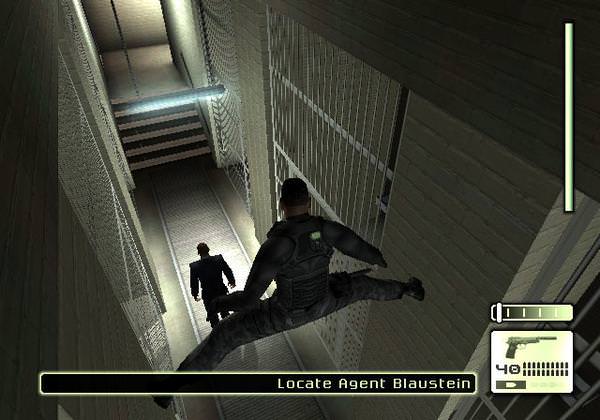
- Gadgets or weapons that allow you to incapacitate or kill enemies from stealth – such as batons, daggers, or even Lara Croft’s bow.
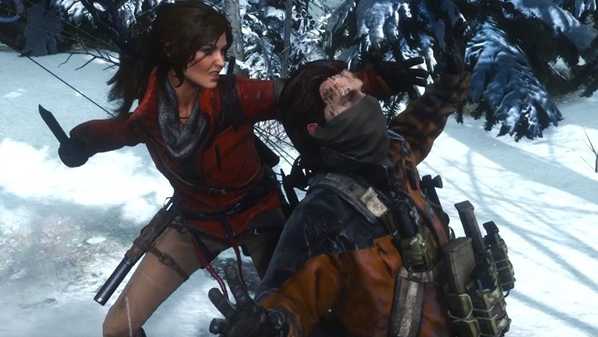
How do you keep the pace of gameplay good and the difficulty appropriate?
I’ve discussed the different types of gadgets and abilities that add much variety to the gameplay and make the player think and strategize. But unfortunately, it is easy to overdo it. If the player has too many gadgets or skills, the game will become too easy or boring.
Since people tend to take the simplest paths, it is almost certain that once they find a method that works for them and is easy, they will stick with it.
For example, if they discover that putting enemies to sleep with arrows is effective and easy, they’ll probably stick with it and may want to play the entire game that way. So they’ll choose what’s easiest for them, but they’ll also get bored quickly. Below you will find ways to avoid this and to get the player to explore different ways and modes of play:
- The items the player uses should wear out and not be too easy to obtain. For example, ammunition and batteries in certain devices should run out, and spying devices should have limited range.
- Enemies can learn the player’s strategies and react accordingly so that the player has to change their ways to survive.
- Some guards may be “immune” to certain player behaviors, e.g., they may be able to recognize the player in disguise.
- In some locations, you cannot use certain items or skills.
- Abstract systems outside the current situation, e.g., killing a guard will raise the alarm.
Victim or hunter?
In stealth games, on the one hand, the player can experience what it’s like to be a victim, be chased, and have limited possibilities to maneuver. This experience works especially well in survival horror games, where stealth sequences are meant to heighten anxiety and build a sense of being trapped. On the other hand, when designing a stealth game, the player is supposed to be more of a victim and shouldn’t have too much advantage over their enemies. For example, they can’t have too many supernatural abilities or gadgets at their disposal. Then, the game would become too easy, and the sense of unease could disappear altogether, completely defeating the purpose of the intended experience.
To make the player feel more like a hunter, you need to give them ample opportunities – to kill or incapacitate enemies or come up with another way out. For example, equip the player with useful gadgets, traps, or the ability to move on the up-down axes.
Summary
Stealth, at first glance, may seem a very schematic genre. And indeed, to some extent, it is – each one must have some fundamental features, such as the presence of curtains, etc. So it may seem that stealth games are easy to design, but it’s really hard to come up with something fresh because this mechanic is so familiar and played out.
_
Want to cite this article? Do it in an elegant way:
Cieślak, K., (2022, 22 04). How to design stealth games?
https://tryevidence.com/blog/how-to-design-stealth-games/


